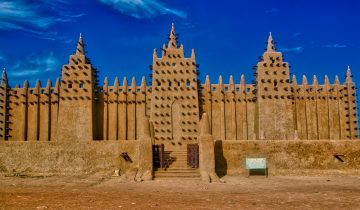African Artist Spotlight Series: Lina Iris Viktor’s Gilded Canvases
As we delve into the mesmerizing world of contemporary African art, we find ourselves captivated by the work of Liberian-British artist Lina Iris Viktor. This journal seeks to explore the intricate, gold-infused masterpieces that define her artistic oeuvre, while celebrating the unique perspectives and techniques that African artists bring to the art world. Throughout this journal, we will uncover the influences that have shaped Viktor’s distinctive style, analyze her innovative methods, and discuss her impact on contemporary art.
Lina Iris Viktor’s background and influences
Born in London to Liberian parents, Lina Iris Viktor grew up in a rich cultural milieu that spanned the African and European continents. Her formal education in the arts began at the esteemed Sarah Lawrence College in New York, where she honed her skills in various disciplines, including painting, sculpture, and photography.
Viktor’s work is deeply rooted in her Liberian and British heritage, which she seamlessly blends into her art. She draws inspiration from the vast tapestry of African art, history, and mythology, as well as the British art scene. This duality in her cultural background manifests itself in her art, creating a fascinating synthesis of traditional African imagery and contemporary Western aesthetics.
A prime example of this intermingling of influences can be seen in her 2018 solo exhibition at the New Orleans Museum of Art, titled “A Haven. A Hell. A Dream Deferred.” This exhibition explored the historical connections between Liberia and the United States, specifically the repatriation of freed American slaves to the African nation. Through her artwork, Viktor weaves a powerful narrative that addresses themes of displacement, identity, and the complexities of the African diaspora.
Lina Iris Viktor’s artistic style
Viktor’s gilded canvases are instantly recognizable for their opulent use of gold leaf, which she meticulously applies to create lavish, intricate patterns. Gold, a symbol of wealth, power, and divine energy, imbues her work with a sense of spiritual and material opulence. In African cultures, gold has long been associated with royalty and divine beings, and Viktor harnesses this symbolism to explore themes of heritage, identity, and the human condition.
Take, for example, her “Constellations” series, which features geometric patterns and celestial imagery painted on black canvases with 24-karat gold leaf. These otherworldly compositions evoke the cosmos and the infinite possibilities of human existence, connecting the viewer to a larger, shared history.
Viktor’s fascination with geometric patterns extends to her incorporation of traditional African symbols and textiles, such as Adinkra symbols and Kente cloth patterns. Adinkra symbols, originating from the Akan people of Ghana, are visual representations of concepts, values, and proverbs. In her work, Viktor employs these symbols to communicate deeper meaning and engage in a visual dialogue with her cultural heritage.
In addition to her use of gold and geometric patterns, Viktor is also celebrated for her powerful portraiture of Black subjects. By presenting her subjects as regal, divine beings adorned with gold, she challenges racial stereotypes and empowers her audience. In her series “Dark Continent,” Viktor reimagines the mythical figure of the African queen, subverting the traditional Western gaze and celebrating the resilience and beauty of Black womanhood.

Impact of Lina Iris Viktor’s work on contemporary art
Viktor’s work occupies a unique space at the intersection of art, history, and identity. By drawing on her dual heritage and incorporating traditional African motifs into her art, she expands the conversation on African art and challenges the Western-centric narrative that has long dominated the art world.
Viktor’s influence can be seen in the work of younger generations of artists, who are increasingly embracing their cultural roots and exploring themes of identity, history, and representation. Artists such as Toyin Ojih Odutola, Wangechi Mutu, and Kehinde Wiley, like Viktor, are breaking new ground in the contemporary art scene by showcasing the diverse and multifaceted nature of African and diasporic experiences.
Her gilded canvases also resonate with collectors, critics, and art enthusiasts, sparking a renewed interest in African art and the stories it tells. The growing popularity of her work has led to numerous exhibitions at prestigious institutions, including the Cooper Gallery at Harvard University, the Autograph ABP in London, and the Studio Museum in Harlem.
Viktor’s impact extends beyond the realm of visual art, as her work has also inspired collaborations with musicians and fashion designers. Most notably, her signature gold-infused style was featured in the music video for Jay-Z and Beyoncé’s song “Apeshit,” showcasing her work to an even broader audience and further cementing her status as a trailblazer in contemporary art.
Viktor’s exploration of the African diaspora resonates with themes of migration, displacement, and belonging. Her work invites the viewer to reflect on the shared histories and experiences that connect people across continents and cultures, while also highlighting the importance of acknowledging and honoring individual narratives.
Moreover, Viktor’s art serves as a powerful reminder of the significance of cultural preservation and the role that artists play in keeping traditions alive. By incorporating traditional African symbols, textiles, and techniques into her work, she not only preserves these cultural elements but also introduces them to new audiences, ensuring that they continue to be celebrated and appreciated.
Lina Iris Viktor’s luxurious, gold-infused canvases offer a stunning glimpse into the rich and diverse world of African art. Her exploration of cultural heritage, identity, and the complexities of the African diaspora has not only enriched the contemporary art scene but also paved the way for greater representation and conversations around the diverse experiences of African and diasporic artists.
As we reflect on Viktor’s gilded masterpieces and the powerful narratives they convey, we are reminded of the transformative power of art to challenge, inspire, and provoke. Her lasting legacy in the art world is certain, as her work continues to influence and captivate both artists and art enthusiasts alike.
In conclusion, Lina Iris Viktor’s gilded canvases offer a multifaceted and thought-provoking exploration of African art, culture, and identity. As we continue to study her work and the broader African art scene, we are presented with an ever-expanding array of perspectives, techniques, and narratives that challenge and enrich our understanding of the world around us.





 No products in the basket.
No products in the basket.